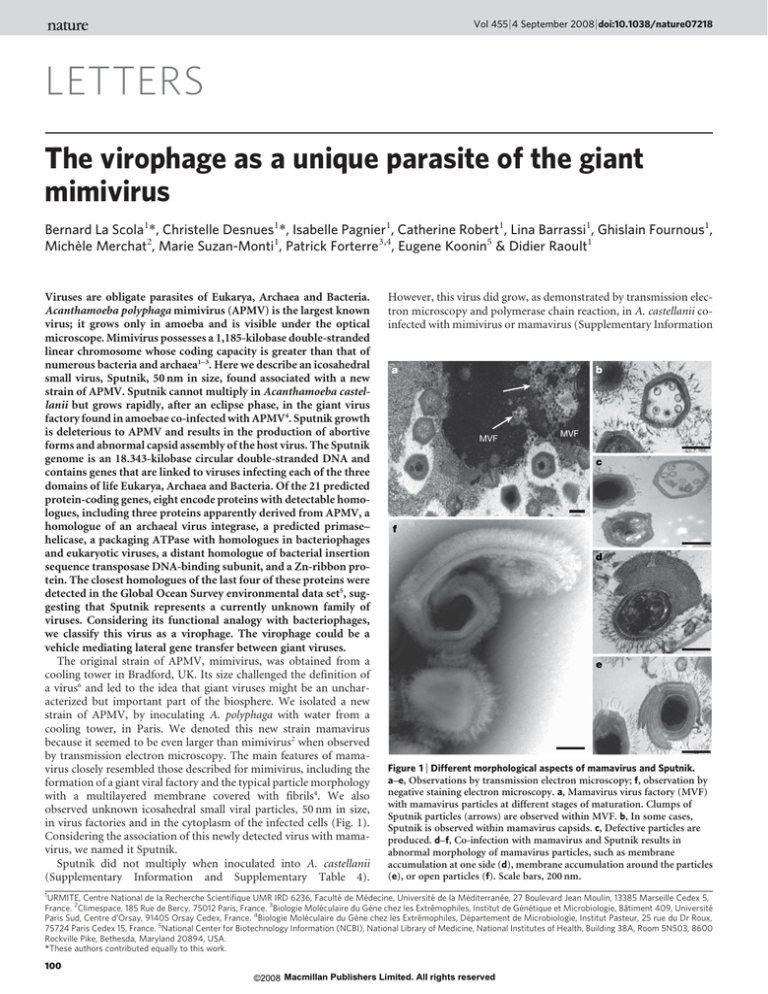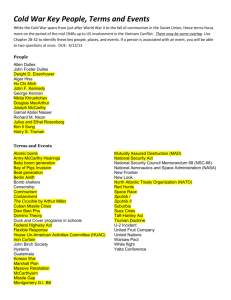
Vol 455 | 4 September 2008 | doi:10.1038/nature07218
LETTERS
The virophage as a unique parasite of the giant
mimivirus
Bernard La Scola1*, Christelle Desnues1*, Isabelle Pagnier1, Catherine Robert1, Lina Barrassi1, Ghislain Fournous1,
Michèle Merchat2, Marie Suzan-Monti1, Patrick Forterre3,4, Eugene Koonin5 & Didier Raoult1
Viruses are obligate parasites of Eukarya, Archaea and Bacteria.
Acanthamoeba polyphaga mimivirus (APMV) is the largest known
virus; it grows only in amoeba and is visible under the optical
microscope. Mimivirus possesses a 1,185-kilobase double-stranded
linear chromosome whose coding capacity is greater than that of
numerous bacteria and archaea1–3. Here we describe an icosahedral
small virus, Sputnik, 50 nm in size, found associated with a new
strain of APMV. Sputnik cannot multiply in Acanthamoeba castellanii but grows rapidly, after an eclipse phase, in the giant virus
factory found in amoebae co-infected with APMV4. Sputnik growth
is deleterious to APMV and results in the production of abortive
forms and abnormal capsid assembly of the host virus. The Sputnik
genome is an 18.343-kilobase circular double-stranded DNA and
contains genes that are linked to viruses infecting each of the three
domains of life Eukarya, Archaea and Bacteria. Of the 21 predicted
protein-coding genes, eight encode proteins with detectable homologues, including three proteins apparently derived from APMV, a
homologue of an archaeal virus integrase, a predicted primase–
helicase, a packaging ATPase with homologues in bacteriophages
and eukaryotic viruses, a distant homologue of bacterial insertion
sequence transposase DNA-binding subunit, and a Zn-ribbon protein. The closest homologues of the last four of these proteins were
detected in the Global Ocean Survey environmental data set5, suggesting that Sputnik represents a currently unknown family of
viruses. Considering its functional analogy with bacteriophages,
we classify this virus as a virophage. The virophage could be a
vehicle mediating lateral gene transfer between giant viruses.
The original strain of APMV, mimivirus, was obtained from a
cooling tower in Bradford, UK. Its size challenged the definition of
a virus6 and led to the idea that giant viruses might be an uncharacterized but important part of the biosphere. We isolated a new
strain of APMV, by inoculating A. polyphaga with water from a
cooling tower, in Paris. We denoted this new strain mamavirus
because it seemed to be even larger than mimivirus2 when observed
by transmission electron microscopy. The main features of mamavirus closely resembled those described for mimivirus, including the
formation of a giant viral factory and the typical particle morphology
with a multilayered membrane covered with fibrils4. We also
observed unknown icosahedral small viral particles, 50 nm in size,
in virus factories and in the cytoplasm of the infected cells (Fig. 1).
Considering the association of this newly detected virus with mamavirus, we named it Sputnik.
Sputnik did not multiply when inoculated into A. castellanii
(Supplementary Information and Supplementary Table 4).
However, this virus did grow, as demonstrated by transmission electron microscopy and polymerase chain reaction, in A. castellanii coinfected with mimivirus or mamavirus (Supplementary Information
a
b
MVF
MVF
c
f
d
e
Figure 1 | Different morphological aspects of mamavirus and Sputnik.
a–e, Observations by transmission electron microscopy; f, observation by
negative staining electron microscopy. a, Mamavirus virus factory (MVF)
with mamavirus particles at different stages of maturation. Clumps of
Sputnik particles (arrows) are observed within MVF. b, In some cases,
Sputnik is observed within mamavirus capsids. c, Defective particles are
produced. d–f, Co-infection with mamavirus and Sputnik results in
abnormal morphology of mamavirus particles, such as membrane
accumulation at one side (d), membrane accumulation around the particles
(e), or open particles (f). Scale bars, 200 nm.
1
URMITE, Centre National de la Recherche Scientifique UMR IRD 6236, Faculté de Médecine, Université de la Méditerranée, 27 Boulevard Jean Moulin, 13385 Marseille Cedex 5,
France. 2Climespace, 185 Rue de Bercy, 75012 Paris, France. 3Biologie Moléculaire du Gène chez les Extrêmophiles, Institut de Génétique et Microbiologie, Bâtiment 409, Université
Paris Sud, Centre d’Orsay, 91405 Orsay Cedex, France. 4Biologie Moléculaire du Gène chez les Extrêmophiles, Département de Microbiologie, Institut Pasteur, 25 rue du Dr Roux,
75724 Paris Cedex 15, France. 5National Center for Biotechnology Information (NCBI), National Library of Medicine, National Institutes of Health, Building 38A, Room 5N503, 8600
Rockville Pike, Bethesda, Maryland 20894, USA.
*These authors contributed equally to this work.
100
©2008 Macmillan Publishers Limited. All rights reserved
LETTERS
NATURE | Vol 455 | 4 September 2008
and Supplementary Table 4). Sputnik and mamavirus were produced
within the same viral factory with different kinetics and at different
specific locations. Sputnik was produced earlier than APMV (Fig. 2).
Sputnik co-infection was associated with a significant increase in the
formation of abnormal mamavirus virions, characterized by partial
thickening of the capsid (11% rather than 1%, P 5 0.0029). In the
regular mamavirus virions, the capsid layer was 40 nm thick; in contrast, in the presence of Sputnik, the thickness of the capsid wall could
reach 240 nm (Fig. 1). In most cases, several capsid layers accumulated asymmetrically at one pole of the viral particle. Some of these
abnormal particles seemed to be mature and to harbour fibrils only
on the normal part of the capsid. Only a small fraction of the mamavirus particles encapsidated Sputnik virions (Fig. 1). However, coinoculation of mamavirus with Sputnik resulted in a roughly 70%
decrease in the yield of infective mamavirus particles and a threefold
decrease in amoeba lysis at 24 h. These findings showed that Sputnik
is a parasite of mamavirus that substantially affects the reproduction
of the host virus.
The Acanthamoeba castellanii mamavirus genome (C.D., B.L.S.,
C.R., G.F. and D.R., unpublished observations) is about 1,200 kilobase
a
d
b
e
c
f
Figure 2 | Sputnik propagation in mamavirus-infected amoebae. A.
castellanii cells were infected with a mixture of mamavirus and Sputnik.
Indirect immunofluorescence labelling was performed with rabbit antimimivirus serum (red) and mouse anti-Sputnik serum (green), and nucleic
acids were stained with 4,6-diamidino-2-phenylindole (DAPI; blue).
a, Numerous Sputnik virions entered the cytoplasm at 30 min after
infection. b, At 4 h after infection, the first viral factories were seen as
distinct, strongly stained patches. No viral particles could be seen in these
cells, indicating an eclipse phase. c, At 6 h after infection, the viral factories
expanded and were homogenously and strongly stained with DAPI. Sputnik
production was detected at one side of the viral factory, but no mamavirus
virions. d–f, At 8 h after infection (d), mamavirus production was observed;
this increased extensively at 12 h (e) and 16 h (f) after infection.
pairs in size. Its genome is highly AT-rich (A 1 T content < 72%).
Orthologues to mimivirus open reading frames (ORFs) were detected
for 99% of the predicted mamavirus genes, with amino-acid identity
ranging from 75% to 100%. Thus, mamavirus is closely related to
mimivirus and could be considered a second strain of APMV.
Sputnik has an 18,343-base-pair (bp) circular double-stranded
DNA genome, with 21 predicted protein-coding genes ranging in size
from 88 to 779 amino-acid residues (Table 1 and Fig. 3). The organization of the Sputnik genome is typical of viral genomes, namely a
tight arrangement but little overlap of the ORFs. The high A 1 T
content (73%) of the Sputnik genome is similar to that of APMV.
Sputnik samples were resolved by two-dimensional gel electrophoresis within a pI range of 3–10 (Fig. 3). The most abundant of the
detected protein spots, analysed by matrix-assisted laser desorption
ionization–time-of-flight (MALDI–TOF) mass spectrometry, corresponded to ORF 20; ORF 08 and ORF 19 proteins were identified once
each. These results were corroborated by western blot analysis with a
mouse anti-serum against purified Sputnik (Supplementary Fig. 1).
Thus, ORF 20 most probably encodes the major capsid protein of
Sputnik, whereas ORFs 08 and 19 encode minor virion proteins.
Genomes of many viruses contain a high proportion of ‘ORFan’
genes; that is, genes without detectable homologues in current
sequence databases. The genome of Sputnik is no exception because
most of its encoded proteins (13 of 21) are ORFans. The eight nonORFan proteins have viral/plasmid, bacterial or eukaryotic homologues, and/or homologues from the environmental Global Ocean
Survey (GOS) data set (Table 1). Three of the Sputnik predicted
proteins (ORFs 6, 12 and 13) were most closely related to mimivirus/mamavirus gene products. The proteins encoded in ORFs 12
and 13 were equally similar to their respective homologues from the
mimivirus and the mamavirus (Supplementary Table 3), whereas
ORF 6 was more closely related to the mamavirus homologue. The
most plausible model is therefore that Sputnik acquired a portion of
the gene (or the complete gene, which was further partly eliminated)
from mamavirus after its divergence from the common ancestor with
mimivirus.
Specifically, ORF 12 is uncharacterized, whereas ORFs 6 and 7
encode paralogous proteins containing highly conserved collagen
triple-helix motifs7. The protein encoded by ORF 13 consists of
two domains implicated in viral DNA replication. The carboxy-terminal domain of this protein is a superfamily 3 helicase that is highly
conserved and clusters with homologues from nucleocytoplasmic
large DNA viruses (NCLDVs)7 in phylogenetic trees (Fig. 3 and
Supplementary Figs 2 and 3). The amino-terminal portion of
ORF 13 protein is a previously unobserved domain for which homologues with high similarity were detected only among proteins from
the GOS data set and which, on the basis of the presence of a signature
sequence motif, could be predicted to represent a highly derived
version of the archaeo-eukaryotic primase (Supplementary Fig. 4).
The ORF 3 protein showed limited similarity to a packaging ATPase
of the FtsK–HerA superfamily that is found in all NCLDVs and many
bacteriophages5,8,9 (Fig. 3 and Supplementary Fig. 5). ORF 14, which
is adjacent to the primase–helicase gene, encodes a protein containing a Zn-ribbon motif that is significantly similar to that in several
proteins in the GOS data set (Table 1 and Supplementary Fig. 6), and
ORF 4 also encodes a Zn-ribbon protein without highly conserved
homologues. ORF 17 encodes a protein with homologues in the GOS
data set that belong to the family of bacterial insertion sequence
transposase DNA-binding subunits/domains (transposase A proteins) (Table 1, Fig. 3 and Supplementary Fig. 7). Finally, ORF 10
protein showed significant sequence similarity to integrases of the
tyrosine recombinase family from archaeal viruses and proviruses, a
relationship that was further supported by phylogenetic analysis
(Fig. 3 and Supplementary Fig. 8).
Two genes implicated in essential functions in viral genome replication and packaging (ORFs 13 and 3, respectively) and a gene with a
potential role in expression regulation (ORF 14) are most closely
101
©2008 Macmillan Publishers Limited. All rights reserved
LETTERS
NATURE | Vol 455 | 4 September 2008
related to genes from the GOS data set. Given that the primase–helicase and the FtsK-like ATPase are typical viral genes, it seems likely
that Sputnik is linked to an unknown family of viruses, perhaps related
to NCLDVs, that is abundantly represented among the marine metagenomic sequences but not in other current sequence databases.
Thus, the Sputnik genome contains genes evolutionarily related to
at least three distinct sources: first, a putative novel family of viruses;
second, an archaeal virus (or plasmid); and third, mimivirus/mamavirus. The three genes shared with mimivirus/mamavirus were probably acquired by Sputnik after the association with APMV was
established, and their products might be involved in the interaction
of the virophage with its viral host. Within viral factories, recombination between the genomes of the virophage and APMV could result in
an exchange of genes. APMV factories are probably capable of replicating foreign DNA, as suggested by experiments demonstrating
efficient plasmid replication in poxvirus10 and in African swine fever
virus factories11. The presence of three genes homologous to mamavirus genes in the Sputnik genome suggests that gene transfer between
Sputnik and mamavirus can occur during infection of Acanthamoeba
by these two viruses together. It has been shown that some bacterial
genes were recently acquired by mimivirus12, but the source and the
route of acquisition are still unknown13. Virophage could be a vehicle
of such gene transfers, as well as of gene transfers between different
giant viruses especially, if provirophages exist—a possibility that
seems particularly plausible given the presence of genes for the predicted integrase and transposase subunit homologue in the virophage
genome.
The integrase gene that is shared between Sputnik and archaeal
viruses (plasmids) might have been independently derived from an
ancestral virus that predated the divergence between archaea and
kDa
ORF 3: FtsK–HerA superfamily ATPase
104.4
97.3
39
28
50
79
50.4
GOS 8413292
GOS 6388064
ORF3 Virophage
GOS 6158
GOS 8407369
Swinepox virus AAL69857.1
ORF 19
ORF 20
Dwarf gourami iridovirus AAY58049.1
73
37.2
ORF 20: major
virion protein
29.2
Spodoptera frugiperda ascovirus YP_762465.1
99
41
Ostreococcus virus OsV5 ABY27879.1
59
100
83
Acanthamoeba polyphaga mimivirus AAV50705.1
Sulfolobus virus STSV1 CAH04252.1
Acidianus two-tailed virus CAI59904.1
Sulfolobus spindle-shaped virus 2
AAQ73250.1
0.5
ORF 8
20.2
ORF 6: collagen triplehelix-containing protein
ORF 19: minor virion
protein
Sputnik virophage
ORF 7: collagen triplehelix-containing protein
18,343 bp
Average GC content 27%
ORF 8: minor virion
protein
ORF 17: transposase DNAbinding subunit (ORF A)
48 GOS 9604835
40 GOS 1672193
64 GOS 9512229
49 GOS 7101084
Sagittula stellata EBA07908.1
Agrobacterium tumefaciens
45
AAK88840.1
Escherichia coli ZP_00926473.1
98
Silicibacter sp.TM1040 ABF65701.1
ORF 17 Virophage
ORF 10: Tyr recombinase family integrase
77
48
33
ORF 12: unknown
function
100
66
0,2
ORF14 Virophage
GOS 3284690
GOS 6504063
GOS 1049
0.1
Thermococcus kodakarensis KOD1 YP_182517.1
ORF10 Virophage
Methanococcus aeolicus Nankai-3 YP 001324883.1
Methanocaldococcus jannaschii DSM 2661
NP_247755.1
Enterobacteria phage P2 NP_046786.1
Enterobacteria phage lambda NP_040609
0.2
ORF 14: Zn-ribbon containing protein
58
Acidianus two-tailed virus YP_319903.1
Sulfolobus virus STSV1 YP_077249.1
ORF 13: SF3 helicase domain (C-terminal)
Clostridium perfringens ZP_02640204.1
Acidianus ambivalens CAA12526.14
Sulfolobus islandicus YP_001569030.1
100
100 Listeria innocua Clip11262 CAC97814.1
87
Listeria phage 2389 CAC85608.1
91
Lactobacillus phage phiadh CAB52501.1
GOS 2347083
Paracoccus denitrificans PD1222 ABL69094.1
Canarypox virus AAR83428.1
91
GOS 2645573
84
GOS 4362
48
92
ORF13 Virophage
GOS 465735
GOS 612019
64
96
Acanthamoeba polyphaga mimivirus Q5UQ22.2
82
Lymphocystis disease virus 1 NP 078717.1
80
86
0.2
Figure 3 | The Sputnik chromosome. The predicted protein coding
sequences are indicated on the two DNA strands (first, outer, circle) and
coloured according to their corresponding homologues. ORFs with
homologues to mamavirus/mimivirus are indicated in blue, ORFs with
homologues to other NCLDVs and bacteriophages are shown in green, and
the ORF homologous to an archaeal virus gene is shown in red. The virion
protein coding sequences are shown in purple and ORFans are shown in
grey. Phylogenetic trees are displayed for the predicted protein coding
sequences with homologues in nr and/or the GOS data sets along with the
2D-gel identifying the capsid protein. GC skew and G 1 C content are
indicated in the second and third circles, respectively. IPG, immobile pHgradient buffer.
102
©2008 Macmillan Publishers Limited. All rights reserved
LETTERS
NATURE | Vol 455 | 4 September 2008
Table 1 | Homologies and predicted functions of the Sputnik protein coding sequences
Gene (size, amino-acid
residues)
Closest homologue in GenBank nr (accession no.,
percentage identity/alignment length/E-value)
Closest homologue in the GOS data set Domain architecture/protein
(percentage identity/alignment length/ family/predicted activity
E-value)
Predicted function in
virophage replication
ORF 1 (144)
ORF 2 (114)
ORF 3 (245)
–
–
RecA-superfamily ATPases (Actinobacillus
pleuropneumoniae serovar 1 str. 4074)
(ZP_00134596.2, 54%/35/0.01) MIMI
L712
Limited similarity to diverse Zn-ribbon
proteins
–
MIMI R196 (YP_142550.1, 53%/128/
4 3 10219)
C1q and tumour necrosis factor related
protein 5, mouse (NP_663588, 27%/
156/0.001) MIMI R239
–
–
Phage integrase family protein
(Methanococcus aeolicus Nankai-3)
(YP_001324883, 32%/166/6 3 10213)
–
MIMI R546 (Q5UR26, 64%/122/5 3 10242)
Putative DNA-polymerase or DNA-primase
(Lactobacillus phage phiadh) (NP_050131.1,
29%/171/4 3 10212) MIMI L207/206
–
–
GOS_6857935 (48%/205/
10237)
Unknown
Unknown
FtsK–HerA superfamily
ATPase
Unknown
Unknown
DNA packaging
–
Zn-ribbon-containing
protein
Unknown
Collagen triple-helixrepeat-containing protein
Collagen triple-helixrepeat-containing protein
Transcription regulation?
Unknown
Protein–protein interactions
in factories
Protein–protein interactions
in factories
–
–
–
Unknown
Unknown
Tyr recombinase family
integrase
Minor virion protein
Unknown
Integration of virophage
into APMV genome?
Unknown
Unknown
Primase–helicase
Unknown
Unkown
DNA replication
Zn-ribbon-containing
protein
Membrane protein
Transcription regulation?
ORF 4 (139)
ORF 5 (119)
ORF 6 (310)
ORF 7 (236)
ORF 8 (184)
ORF 9 (175)
ORF 10 (226)
ORF 11 (162)
ORF 12 (152)
ORF 13 (779)
–
GOS_3129237 (59%/130/
10223)
GOS_8448924 (57%/40/
0.002)
ORF 14 (114)
–
–
–
Putative highly derived
N-terminal primase domain,
GOS_5022207 (32%/200/
8 3 10218) C-terminal SF3
helicase domain GOS_2645573
(32%/409/4 3 10246)
GOS_3284690 (45%/48/0.02)
ORF 15 (109)
–
–
ORF 16 (130)
ORF 17 (88)
–
–
–
GOS_9512229 (27%/80/0.03)
ORF 18 (167)
ORF 19 (218)
ORF 20 (595)
ORF 21 (438)
–
–
–
–
–
–
–
-
eukaryotes. Alternatively, Sputnik might have acquired this gene
from a virus (plasmid) harboured by an archaeal endosymbiont residing in a eukaryotic cell infected by Sputnik. Regardless of the exact
source of this gene, one of the most remarkable features of the virophage is its apparent chimaeric origin. This seems to be one of the
most convincing cases so far of gene mixing and matching within the
virus world14. A search for additional virophages should shed more
light on this unique mode of interaction between viruses.
As Sputnik multiplies in the APMV giant factories, it resembles
satellite viruses of animals (for example adeno-associated viruses or
hepatitis D virus) and plants (for example satellite tobacco necrosis virus)15. However, Sputnik reproduction seems to impair the
production of normal APMV virions significantly, indicating that
it is a genuine parasite. To our knowledge, this observation of a virus
using the viral factory of another virus to propagate at the expense of
its viral host has not been described previously. We have therefore
termed this virus a virophage by analogy with bacteriophages; should
other similar agents be discovered in the future, virophage could be
used as a generic name to denote them.
Isolation of viruses was performed on water sampled in a cooling tower as
described previously16. For developmental cycle analysis, A. castellanii cells were
infected with mamavirus alone or with Sputnik (Supplementary Information)
and examined by transmission electronic microscopy and fluorescence as
described previously for mimivirus4.
Large volumes of A. castellanii infected by mamavirus and Sputnik were cultured. The culture supernatants were then filtered through 0.8-mm and 0.2-mm
membranes. Sputnik particles were concentrated from the 0.2-mm filtrate,
whereas mamavirus was obtained by washing the 0.2-mm membranes with K36
buffer. DNA was extracted by following the mimivirus procedure1. The genomes
of the two viruses were sequenced on the 454-Roche GS20 as described17. Putative
Unknown
Minor virion protein
Major capsid protein
Unknown
open reading frames were searched with GeneMark.hmm 2.0 (ref. 18), and translated sequences were compared with GenBank nr and the GOS data set (http://
www.ncbi.nlm.nih.gov). MAFFT version 6 (ref. 19) or MUSCLE20 was used to
construct multiple alignments, and MEGA 4 (ref. 21) or TREEFINDER22 was used
to construct phylogenetic trees. Peptide data from excised spots were analysed by
MALDI–TOF mass spectrometry as reported previously23. For western blot analysis, sera of BALB/c mice immunized with mamavirus or Sputnik were first
absorbed on mimivirus and then on amoebae lysate.
Full Methods and any associated references are available in the online version of
the paper at www.nature.com/nature.
Received 16 June; accepted 27 June 2008.
Published online 6 August 2008.
1.
2.
3.
4.
5.
METHODS SUMMARY
Unknown
IS3 family transposase
A protein
Unknown
Unknown
Unknown
Unknown
Modification of APMV
membrane?
Unknown
DNA-binding protein
6.
7.
8.
9.
Raoult, D. et al. The 1.2-megabase genome sequence of Mimivirus. Science 306,
1344–1350 (2004).
La Scola, B. et al. A giant virus in amoebae. Science 299, 2033 (2003).
Koonin, E. V. Virology: Gulliver among the Lilliputians. Curr. Biol. 15, R167–R169
(2005).
Suzan-Monti, M., La Scola, B., Barrassi, L., Espinosa, L. & Raoult, D. Ultrastructural
characterization of the giant volcano-like virus factory of Acanthamoeba
polyphaga Mimivirus. PLoS ONE 2, e328 (2007).
Rusch, D. B. et al. The Sorcerer II Global Ocean Sampling expedition: northwest
Atlantic through eastern tropical Pacific. PLoS Biol. 5, e77 (2007).
Raoult, D. & Forterre, P. Redefining viruses: lessons from Mimivirus. Nature Rev.
Microbiol. 6, 315–319 (2008).
Rasmussen, M., Jacobsson, M. & Bjorck, L. Genome-based identification and
analysis of collagen-related structural motifs in bacterial and viral proteins. J. Biol.
Chem. 278, 32313–32316 (2003).
Williamson, S. J. et al. The Sorcerer II Global Ocean Sampling Expedition:
metagenomic characterization of viruses within aquatic microbial samples. PLoS
ONE 3, e1456 (2008).
Iyer, L. M., Makarova, K. S., Koonin, E. V. & Aravind, L. Comparative genomics of
the FtsK–HerA superfamily of pumping ATPases: implications for the origins of
chromosome segregation, cell division and viral capsid packaging. Nucleic Acids
Res. 32, 5260–5279 (2004).
103
©2008 Macmillan Publishers Limited. All rights reserved
LETTERS
NATURE | Vol 455 | 4 September 2008
10. De Silva, F. S. & Moss, B. Origin-independent plasmid replication occurs in
vaccinia virus cytoplasmic factories and requires all five known poxvirus
replication factors. Virol. J. 2, doi:10.1186/1743-422X-2-23 (2005).
11. Oliveira, S. & Costa, J. V. Replication of transfected plasmid DNA by cells infected
with African swine fever virus. Virology 207, 392–399 (1995).
12. Filee, J., Siguier, P. & Chandler, M. I am what I eat and I eat what I am: acquisition of
bacterial genes by giant viruses. Trends Genet. 23, 10–15 (2007).
13. Moreira, D. & Brochier-Armanet, C. Giant viruses, giant chimeras: the multiple
evolutionary histories of Mimivirus genes. BMC Evol. Biol. 8, doi:10.1186/14712148-8-12 (2008).
14. Koonin, E. V., Senkevich, T. G. & Dolja, V. V. The ancient Virus World and
evolution of cells. Biol. Direct 1, doi:10.1186/1745-6150-1-29 (2006).
15. Fauquet, C. M., Mayo, M. A., Maniloff, J., Desselberger, U. & Ball, L. A. (eds) Virus
Taxonomy (Eighth Report of the International Committee on Taxonomy of Viruses)
1163–1169 (Elsevier, London, 2005).
16. La Scola, B., Barrassi, L. & Raoult, D. Isolation of new fastidious a-Proteobacteria
and Afipia felis from hospital water supplies by direct plating and amoebal coculture procedures. FEMS Microbiol. Ecol. 34, 129–137 (2000).
17. Margulies, M. et al. Genome sequencing in microfabricated high-density picolitre
reactors. Nature 437, 376–380 (2005).
18. Lukashin, A. V. & Borodovsky, M. GeneMark.hmm: new solutions for gene finding.
Nucleic Acids Res. 26, 1107–1115 (1998).
19. Katoh, K., Misawa, K., Kuma, K. & Miyata, T. MAFFT: a novel method for rapid
multiple sequence alignment based on fast Fourier transform. Nucleic Acids Res.
30, 3059–3066 (2002).
20. Edgar, R. C. MUSCLE: multiple sequence alignment with high accuracy and high
throughput. Nucleic Acids Res. 32, 1792–1797 (2004).
21. Tamura, K., Dudley, J., Nei, M. & Kumar, S. MEGA4: Molecular Evolutionary Genetics
Analysis (MEGA) software version 4.0. Mol. Biol. Evol. 24, 1596–1599 (2007).
22. Jobb, G., von Haeseler, A. & Strimmer, K. TREEFINDER: a powerful graphical
analysis environment for molecular phylogenetics. BMC Evol. Biol. 4, doi:10.1186/
1471-2148-4-18 (2004).
23. Kowalczewska, M. & Raoult, D. Advances in Tropheryma whipplei research: the rush
to find biomarkers for Whipple’s disease. Future Microbiol. 2, 631–642 (2007).
Supplementary Information is linked to the online version of the paper at
www.nature.com/nature.
Acknowledgements We thank X. de Lamballerie, S. Azza, P. de Clocquement,
L. Espinosa, B. Campagna, N. Aldrovandi, V. Brice, A. Bernard, C. Ivars, B. Giumelli
and Y. Wolf for expert assistance. This work was funded by the Centre National de
la Recherche Scientifique (CNRS, crédits récurrents). I.P. is funded by a CIFFRE
fellowship, E.K. is supported by the Intramural Research Program of the National
Institutes of Health, National Library of Medicine, and P.F. is funded by the Institut
Universitaire de France.
Author contributions D.R. and B.L.S. supervised the project and wrote the
manuscript. C.D., P.F. and E.K. contributed to sequence analysis, interpretation of
the results and writing of the manuscript. I.P. isolated the virus. M.S.-M.
contributed to viral cycle analysis, interpretation of the results and writing of the
manuscript. M.M. provided water samples. L.B. conducted the viral cycle
experiment. C.R. and G.F. sequenced the genome.
Author Information The virophage genome has been deposited in GenBank under
accession number EU606015. The Acanthamoeba castellanii mamavirus genes with
homologues found in the Sputnik genome have been deposited in GenBank under
accession numbers EU827539–EU827541. Reprints and permissions information
is available at www.nature.com/reprints. Correspondence and requests for
materials should be addressed to D.R. (didier.raoult@gmail.com).
104
©2008 Macmillan Publishers Limited. All rights reserved
doi:10.1038/nature07218
METHODS
Inactivation of Sputnik. To obtain a pure suspension of mamavirus we proposed
that, as observed previously for mimivirus1, it would be resistant to high temperatures. We therefore subjected a supernatant containing Sputnik and mamavirus to 65 uC for 1 h. This suspension was then diluted in PAS (Page’s amoebal
saline) buffer by tenfold dilutions from 1021 to 10210. Each dilution was inoculated into four culture wells of a suspension of fresh amoebae and observed daily
for lysis under an inverted microscope. The last dilution producing lysis in one in
four wells was 1025. The supernatant of this well was subcultured onto fresh
amoebae, and an absence of Sputnik was verified by transmission electronic
microscopy, immunofluorescence staining and Sputnik-specific PCR (see
Supplementary Methods and Supplementary Results).
Evaluation of the effect of Sputnik on the developmental cycle of mamavirus.
Supernatant containing Sputnik and mamavirus from infected A. castellanii was
filtered through a 0.2-mm membrane and the Sputnik-containing filtrate was
saved. A suspension of 10 ml of pure mamavirus was divided between two tubes.
In tube 1, 200 ml of the Sputnik-containing supernatant was added. In tube 2,
200 ml of PAS buffer was added. A. castellanii cells (10 ml, 5 3 105 ml21 in PAS
buffer) were inoculated into culture flasks. In one flask, 1 ml of tube 1 was added;
in a second flask, 1 ml of tube 2 was added, and 1 ml of PAS was added in the third
flask. Living trophozoites were counted in each flask after 24 h. At 48 h after
inoculation, mamavirus (flask 2) or Sputnik and mamavirus (flask 1) culture
supernatants were used for titration of mamavirus and were then frozen.
Titration was performed by endpoint dilution from 1021 to 10210 as described
above and then with fivefold dilutions from 1024 to 1026. Dilutions were scored
until day 5 for lysis indicating mamavirus multiplication. The presence or
absence of mamavirus multiplication was confirmed by detection with PCR in
the supernatants from wells (data not shown).
To evaluate the effect of Sputnik on the appearance of abnormal mamavirus
particles, monolayers of A. castellanii cells infected by mamavirus alone and by
Sputnik and mamavirus were prepared for transmission electron microscopy. To
normalize the comparison, counts of viral particles were performed in an area
with a width of 1.5 mm around the virus factory limits.
Purification of viruses, preparation of viral DNA, and sequencing of Sputnik
virus and mamavirus genomic DNA. Large volumes of A. castellanii cells
infected by mamavirus and Sputnik were cultured. Viral supernatant were collected at 24–48 h, when lysis of amoebae was almost complete, by low-speed
(100g) centrifugation for 15 min.
Sputnik was purified by filtration on 0.8-mm and 0.2-mm membranes. The
filtrate was concentrated by ultracentrifugation at 100,000g for 70 min at 4 uC.
The pellet was resuspended in K36 buffer, loaded on a 25% sucrose cushion in
K36 and centrifuged with the same conditions. The purified pellet was washed
once in K36 and resuspended in 10 mM Tris-HCl, 1 mM EDTA. To avoid contamination from DNA and RNA from amoebae, the suspension was treated twice
with 10 ml of DNaseI_RNaseI-free (Roche) and 10 ml of RNaseI_DNaseI-free
(Roche) and incubated for 60 min at 37 uC. The enzymes were inactivated by
heating for 10 min at 70 uC. The DNA was extracted by following the mimivirus
procedure1. A semiquantitative PCR was performed with primers specific for the
18S rRNA gene from amoebae1 to estimate the contamination with DNA from
amoebae. The Sputnik genome was pyrosequenced on 454–Roche GS20 as
described17. The raw data were assembled by the gsAssembler of the GSFLX
(35-bp overlap; 95% identity) leading to a large contig of 16.9 kilobases (kb)
and four smaller contigs, for a total of 1.08 kb. Four primer sets were designed to
close the molecule by PCR.
To obtain mamavirus DNA, the 0.2-mm membranes were washed with K36
buffer and this suspension was processed as above for sucrose density purification and for treatments with DNase/RNase. The pellet was then resuspended in
TSD buffer (40 mM Tris-HCl pH 8, 2% SDS, 60 mM dithiothreitol) and incubated for 30 min at 60 uC with checking for lysis. If needed, an additional 25 ml of
buffer was added to achieve total lysis, and this could be repeated three times. The
suspension was diluted 1:10 in 50 mM Tris-HCl and treated with 10% Proteinase
K at 56 uC. After three phenol/chloroform extractions, the DNA was precipitated
with ethanol and resuspended in 75 ml of 10 mM Tris-HCl, 1 mM EDTA. The
quality and the yield of the DNA was analysed on an agarose gel and stained with
ethidium bromide. A semiquantitative PCR was performed with primers targeting the 18S rRNA gene from amoebae1 to estimate contamination with DNA
from amoebae. The mamavirus genome was also sequenced on 454–Roche GS20
and assembled with gsAssembler (40-bp overlap; 90% identity); 43 large contigs
(more than 1.5 kb) were constructed for a genome size of 1.18 megabases. The
average contig size was 27 kb; the largest was 173 kb. Taking into account all the
contigs, 163 were obtained for a genome size of about 1.20 megabases.
Sequence analyses. Putative ORFs were defined with GeneMark.hmm 2.0 (ref.
18). Significant similarities of the ORF translated sequences were assessed
through BLASTP and psi-BLAST24 searches against the NCBI non-redundant
protein database (http://www.ncbi.nlm.nih.gov). Functional motifs and conserved domains were identified by searches against PFAM version 22.0 (ref.
25), the Conserved Domain Database (CDD version 2.13), and SMART26.
Homologues of Sputnik proteins in the environmental sequence data were
detected by searching the NCBI environmental data set using BLASTP.
Analyses of GC percentages and GC skew were performed with the online
DNA Base Composition Analysis Tool (http://molbiol-tools.ca). The genome
map was generated with Genomeviz27. MAFFT version 6 (ref. 19) or MUSCLE20
was used to construct multiple alignments. Phylogenetic analyses were conducted with MEGA 4 (ref. 21) or TREEFINDER22.
24. Altschul, S. F. et al. Gapped BLAST and PSI-BLAST: a new generation of protein
database search programs. Nucleic Acids Res. 25, 3389–3402 (1997).
25. Finn, R. D. et al. Pfam: clans, web tools and services. Nucleic Acids Res. 34,
D247–D251 (2006).
26. Letunic, I. et al. SMART 4.0: towards genomic data integration. Nucleic Acids Res.
32, D142–D144 (2004).
27. Ghai, R., Hain, T. & Chakraborty, T. GenomeViz: visualizing microbial genomes.
BMC Bioinformatics 5, doi:10.1186/1471-2105-5-198 (2004).
©2008 Macmillan Publishers Limited. All rights reserved






